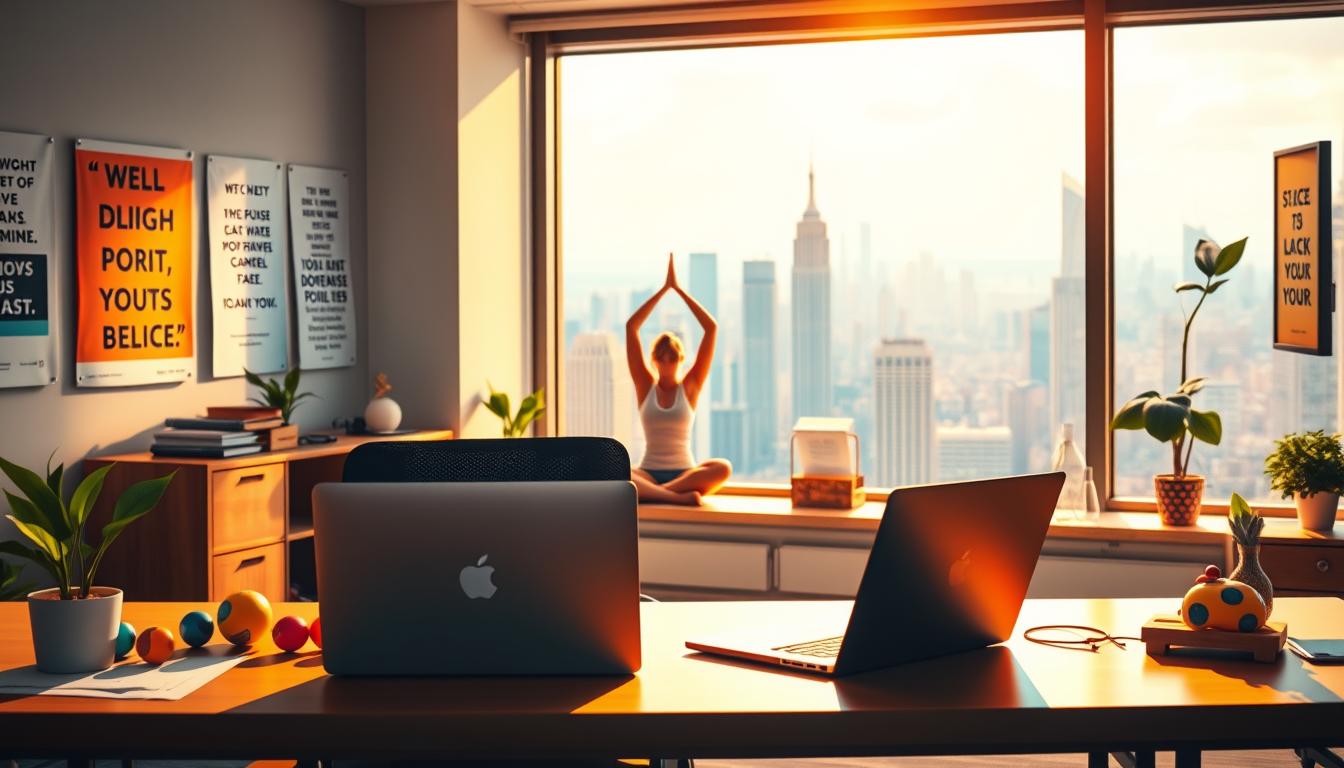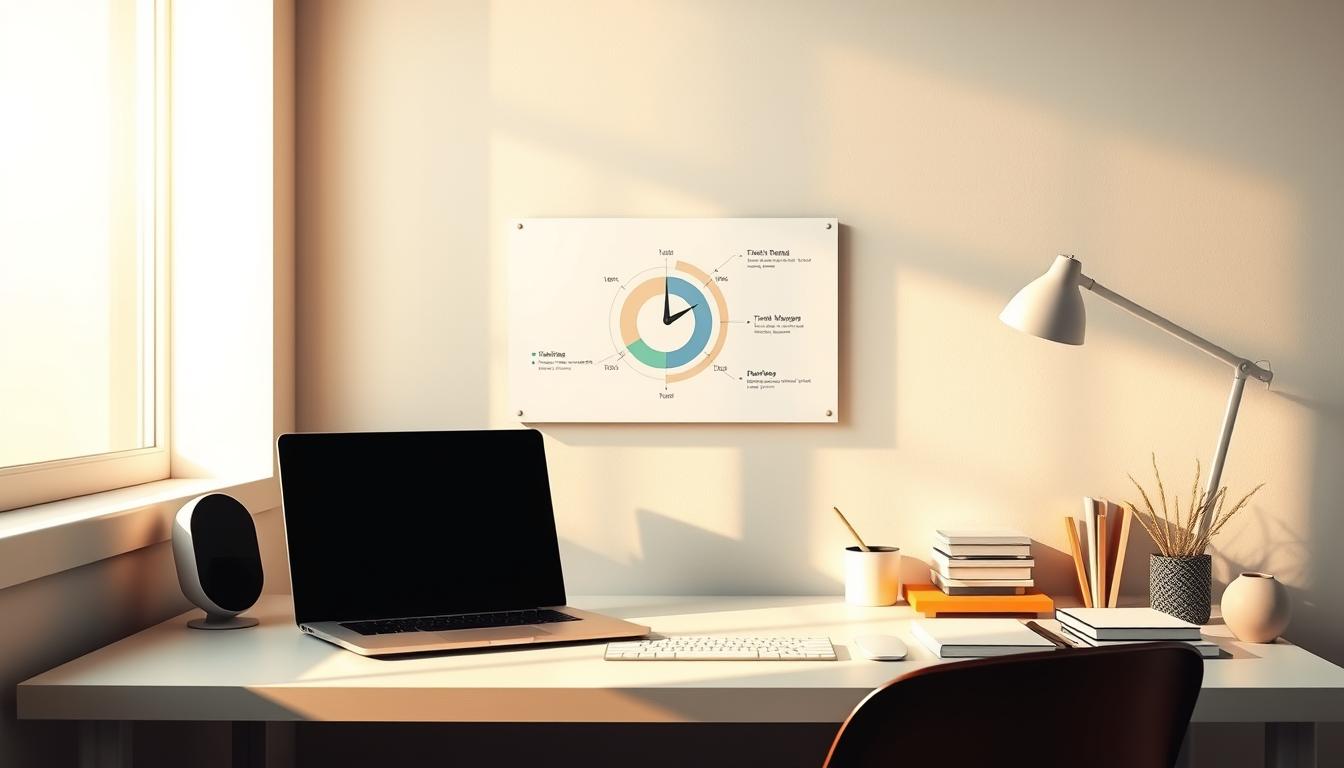Did you know 80% of workers feel stressed at work? And 40% say their stress is “high” or “very high.”

Workplace stress is not just personal. It affects how well we work, our happiness, and our health. You can make your work place better and feel less stressed with the right steps.
Managing workplace stress is key to a good work-life balance. In this article, you’ll find 12 stress management techniques. They can help you deal with work stress and make your life better.
Key Takeaways
- Understand the impact of workplace stress on your well-being and productivity.
- Learn 12 actionable techniques to manage stress at work.
- Discover how to maintain a healthy work-life balance.
- Improve your overall quality of life with effective stress management.
- Take the first step towards a less stressful work environment.
The Hidden Cost of Workplace Stress
Workplace stress can cause many problems. It affects your job and health. It can change many parts of your life.
Physical and Mental Health Impacts
Chronic stress hurts your body and mind. It can cause anxiety, depression, and heart problems. The “fight or flight” response is meant to be short. But, it can harm your body if it lasts too long.
How Chronic Stress Affects Your Career Performance
Work stress can make you less productive. It’s hard to focus and make decisions when stressed. This can make your stress worse.
“Stress is not just a feeling; it’s a physical response that can have serious health implications if not managed properly.”
Signs You Need Better Stress Management Strategies
If you’re always tired, irritable, or unmotivated, you might need better stress handling. Spotting these signs early helps you manage stress better.
Good workplace stress management means knowing when you’re stressed. Then, use stress management techniques to lessen its effects. This way, you can feel better and do better at work.
1. Practice Mindful Breathing and Meditation
Workplace stress can be lessened with simple mindfulness practices. Mindful breathing and meditation are great for reducing stress and boosting focus. Adding these to your daily routine can make your work place calmer and more productive.
5-Minute Breathing Exercises for Immediate Stress Relief
The 4-7-8 breathing exercise is a good start. Breathe in for 4 counts, hold for 7, then breathe out for 8. It’s quick and helps right away. Another method is box breathing, where you breathe in for 4, hold for 4, breathe out for 4, and hold again for 4. You can do these quietly at your desk.

Incorporating Brief Meditation Sessions into Your Workday
Even short meditation sessions are helpful. Start with 5-minute sessions, focusing on your breath or a mantra. Guided meditation apps are great for beginners. Try to meditate during breaks for better results.
Scientific Benefits of Mindfulness for Workplace Stress
Studies show mindfulness lowers stress and anxiety by reducing cortisol. It also improves emotional control and thinking skills. This leads to better decisions and work. Regular mindfulness changes the brain, making it more resilient to stress.
2. Establish Clear Boundaries Between Work and Personal Life
Setting clear boundaries between work and personal life helps a lot. It reduces stress and makes you feel better. If work and personal life mix too much, you can get burned out. This can hurt your relationships and health.
Creating Digital Boundaries with Notifications and Emails
Managing digital stuff is hard when trying to balance work and life. Here’s how to set digital boundaries:
- Turn off work notifications when you’re not working.
- Make your email auto-respond with your work hours.
- Use different devices or profiles for work and personal stuff.

Physical Separation Techniques for Remote Workers
Remote workers need a clear space for work. Try these:
- Have a special place for work that’s only for that.
- Use a divider or screen to keep work separate from home.
- Have a special ritual to end your workday.
How to Communicate Your Boundaries to Colleagues and Managers
Telling others about your boundaries is important. You can:
| Boundary | How to Communicate |
|---|---|
| Work Hours | Put your work hours in your email signature or team calendar. |
| Response Time | Tell your team how fast you’ll answer emails and messages. |
| Workload | Talk to your manager about your work to set priorities and manage expectations. |
Setting and sharing your boundaries helps protect your personal time. It reduces stress and makes life better.
3. Prioritize Tasks with Effective Time Management
Learning to manage your time well can make work less stressful. It helps you do what’s most important and feel less overwhelmed.
Using the Eisenhower Matrix to Eliminate Overwhelm
The Eisenhower Matrix helps sort tasks by how urgent and important they are. It breaks tasks into four areas: urgent and important, important but not urgent, urgent but not important, and not urgent or important. This tool helps you know which tasks to do first, delegate, or skip.

Time-Blocking Strategies for Enhanced Productivity
Time-blocking means setting aside big chunks of time for important tasks. This method keeps you focused and stops multitasking, which slows you down. By setting times for tasks, you make sure you’re working on what matters most.
Dealing with Unexpected Tasks and Interruptions
Even with good planning, surprises and interruptions happen. Having a flexible schedule helps you adjust. You can also group similar tasks or add buffer times to handle surprises.
Using these time management tips can lower stress, boost productivity, and improve your work-life balance.
4. Take Strategic Breaks Throughout the Day
To handle work stress well, taking breaks is key. Breaks help you recharge and focus better. They also make you more productive.
The Pomodoro Technique for Balanced Work Sessions
The Pomodoro Technique is about working in 25-minute chunks. Then, you take a 5-minute break. After four of these, take a 15-30 minute break to rest.

Restorative Break Activities That Actually Work
Restorative breaks help you relax. Try a short walk, deep breathing, or meditation. You can also stretch, read, or listen to calm music.
How Microbreaks Improve Focus and Reduce Stress
Microbreaks are short, 1-2 minute breaks. They help you focus and lower stress. Regular microbreaks reduce eye strain and refresh your mind.
5. Build a Supportive Workplace Network
A supportive network at work can change your life. It helps you deal with stress and do better at your job. Having friends at work who get you can really help your happiness.

Finding and Nurturing Workplace Allies
Finding work friends is key. Look for people who think like you and want to help. Keep in touch and support each other to grow your network.
How to Have Constructive Conversations About Workload
Talking about your work load is important. Say what’s hard for you clearly. Listen to others and be open to new ideas. This can make your work easier.
Creating Support Systems for High-Pressure Situations
Plan for tough times at work. Have team talks, be a buddy, or offer advice. These steps can make you feel less stressed.
6. Incorporate Regular Physical Activity
Make physical activity a part of your daily work life to fight workplace stress. It not only cuts down stress but also boosts well-being and work output. Adding simple exercises to your day can bring these benefits to you.

Desk-Friendly Exercises to Release Physical Tension
Try simple desk exercises to ease physical tension. Stretch your arms up, roll your neck, or walk to the water cooler. These small actions can greatly improve your day.
Chair squats and desk push-ups are great for your desk. They boost blood flow and ease muscle tightness.
The Connection Between Movement and Mental Clarity
Movement and mental clarity are closely tied. Exercise boosts blood flow to the brain, sharpening focus and concentration. A short walk can clear your mind and help with tough tasks.
“Exercise is a celebration of what your body can do, not a punishment for what you ate.” – Unknown
Fitting Exercise into Your Busy Work Schedule
It’s tough to fit exercise into a busy schedule, but it’s doable. Try taking the stairs or having a walking meeting. Even a few minutes of activity can help a lot.
Use your lunch break for exercise. A quick walk or workout can refresh you for the rest of the day.
7. Optimize Your Workspace for Reduced Stress
A well-designed workspace can make you feel less stressed. It can also make you feel better overall. Just a few simple changes can make your work area comfy and productive.
Ergonomic Adjustments for Physical Comfort
It’s important to make your workspace ergonomic for comfort. Make sure your chair is the right height. Your feet should be flat on the floor or on a footrest.
Your knees should be at or below hip level. Place your monitor right in front of you. It should be about an arm’s length away and slightly below your line of sight.
Creating a Personalized Stress-Reducing Environment
Make your workspace your own to reduce stress. Add plants like snake plants or peace lilies. They help clean the air and make your space calm.
Think about using a noise machine or app. It can play soothing sounds to block out distracting noises.
Organization Strategies to Minimize Visual Stress
Keeping your workspace organized is key to avoiding visual stress. Use filing cabinets and desk organizers. They should keep important things within reach but out of sight.
Don’t let clutter build up. Regularly clean out your workspace to keep it tidy.
By following these tips, you can make a workspace that’s good for you. It will help you feel better and work better too.
8. Develop Emotional Intelligence in the Workplace
To handle workplace challenges, emotional intelligence is key. It helps you understand and control your feelings. This leads to better stress handling and stronger work relationships.
Recognizing Your Emotional Triggers in Professional Settings
Knowing what makes you upset at work is important. Think about times when you felt stressed. Spotting these patterns helps you grow emotionally.
Techniques for Regulating Emotions During Conflicts
Keeping calm in tough times is vital. Try deep breathing or pausing before you speak. Remember, “The key to successful leadership is influence, not authority.” – Ken Blanchard.

Using Empathy to Navigate Challenging Workplace Dynamics
Empathy is a strong ally at work. It lets you connect with your team and solve problems together. This makes your workplace better and more productive.
Getting better at emotional intelligence takes effort. But it’s worth it for your career and happiness.
9. Learn How to Manage Stress at Work Through Proper Nutrition
Eating the right foods can help you manage stress. Good nutrition supports your body and mind at work.
Stress-Fighting Foods to Include in Your Workday Meals
Some foods can fight stress. Try these:
- Fatty Fish: They have omega-3s that lower stress hormones.
- Nuts and Seeds: Almonds, sunflower seeds, and pumpkin seeds have magnesium and healthy fats.
- Leafy Greens: Spinach and kale have folate for better mood.

Hydration Strategies for Optimal Brain Function
Drinking water is key for focus and less stress. Drink water all day. Herbal teas can also help you relax.
Avoiding Stress-Inducing Eating Habits and Substances
Stay away from foods and drinks that make stress worse. Avoid high-caffeine drinks, sugary snacks, and processed foods. They can make you feel tired and anxious.
Choosing the right foods can help you handle work stress better. It also improves your health.
10. Leverage Technology for Stress Management
Today’s fast world can be stressful. But, technology can help a lot. It offers digital tools and apps to lower stress and boost well-being.
Top Apps for Mindfulness and Stress Reduction
Apps like Headspace and Calm are great for stress. They guide you in meditation. This helps you relax and focus better.
These apps are perfect for quick mindfulness breaks. You can use them at work or at home.
Digital Organization Tools to Combat Information Overload
Tools like Trello and Asana help manage tasks. They make your work feel less overwhelming. You can sort tasks into projects and focus on what’s important.
Setting Up Automation to Reduce Repetitive Stressors
Automation tools cut down on boring tasks. For example, they can send emails or make reports for you. This saves time and mental energy.
| Tool | Purpose | Benefits |
|---|---|---|
| Headspace | Mindfulness and Meditation | Reduces stress, improves focus |
| Trello | Task Management | Enhances organization, prioritization |
| Zapier | Automation | Reduces repetitive tasks, saves time |

11. Practice Cognitive Reframing and Positive Self-Talk
You can handle work stress by changing how you think and talk to yourself. Cognitive reframing is about seeing challenges differently. Positive self-talk keeps your mind upbeat.
Identifying and Challenging Negative Thought Patterns
First, notice when you think negative thoughts. Then, ask if these thoughts are true or just guesses. Swap out negative thoughts for more positive ones.
Developing a Growth Mindset for Workplace Challenges
Seeing challenges as chances to grow is key. Believe you can learn new skills and face tough tasks head-on.
Self-Compassion Techniques for High-Pressure Situations
Be kind to yourself when things get tough. Remember, it’s okay to make mistakes. You’re doing your best.
Using cognitive reframing and positive self-talk daily can make you stronger. It helps you deal with work stress better.
| Technique | Description | Benefit |
|---|---|---|
| Cognitive Reframing | Changing negative thought patterns | Reduces stress |
| Positive Self-Talk | Maintaining a positive mindset | Boosts resilience |
12. Seek Professional Support When Needed
When workplace stress gets too much, it’s key to know when to ask for professional support. Managing stress is not just about trying hard on your own. Sometimes, you need experts who can give you specific help and advice.
Recognizing When Workplace Stress Becomes Overwhelming
First, you need to spot the signs that stress is getting too much. Look out for things like feeling very tired, not being able to do your job well, and getting angry easily. If stress is messing with your life and work, it’s time to get professional help.
Types of Professional Support Available
There are many kinds of professional support for workplace stress. You can find counseling, stress management classes, and mental health programs. Many companies have employee assistance programs (EAPs) that give you access to these services.
How to Utilize Employee Assistance Programs and Benefits
Employee Assistance Programs (EAPs) help you deal with work and personal issues. Learn what services they offer, like counseling, money advice, and legal help. Don’t be shy to ask for help – these programs are private and made to help you handle workplace stress better.
Conclusion: Building Your Personalized Stress Management Toolkit
You now have a guide to manage stress at work with 12 proven techniques. You can mix these strategies to make a stress management toolkit just for you. It will fit your needs and work place.
Try out different techniques to see what works best for you. You might like mindful breathing, setting clear boundaries, or using tech for stress relief. As you build your toolkit, you’ll get better at handling work challenges. This helps you keep a healthy balance between work and life, making your workplace better.
Managing stress is an ongoing task. Keep checking and changing your toolkit to keep it working well. This way, you’ll be stronger and ready for your job’s demands. You’ll also keep your well-being in check.
FAQ
What are some simple stress management techniques I can use at work?
Try mindful breathing, meditation, or short breaks to stretch. These can cut down stress and boost focus.
How can I establish a healthy work-life balance?
Set clear work and personal life boundaries. Use digital and physical barriers. Tell your team and bosses about these limits.
What is the Eisenhower Matrix, and how can it help with time management?
The Eisenhower Matrix sorts tasks by urgency and importance. It helps you focus on what’s most critical.
How can I reduce stress in my workspace?
Make your space ergonomic and personal. Use organization to cut down visual stress.
What role does emotional intelligence play in managing workplace stress?
Emotional intelligence lets you spot emotional triggers and manage them. It helps you handle conflicts and use empathy.
Can nutrition really impact my stress levels at work?
Yes, eating right and staying hydrated can help. Avoid foods that make you stressed. A healthy diet boosts your well-being.
How can technology help with stress management?
Use mindfulness apps and digital tools to reduce stress. Tech can make your work life better.
What is cognitive reframing, and how can it help with stress management?
Cognitive reframing changes negative thoughts into positive ones. It builds resilience and helps you handle stress better.
When should I seek professional support for workplace stress?
If stress is too much, get help. Use employee programs or counseling to manage stress.
How can I build a personalized stress management toolkit?
Try different techniques to find what works for you. Create a mix of strategies to manage stress and improve well-being.